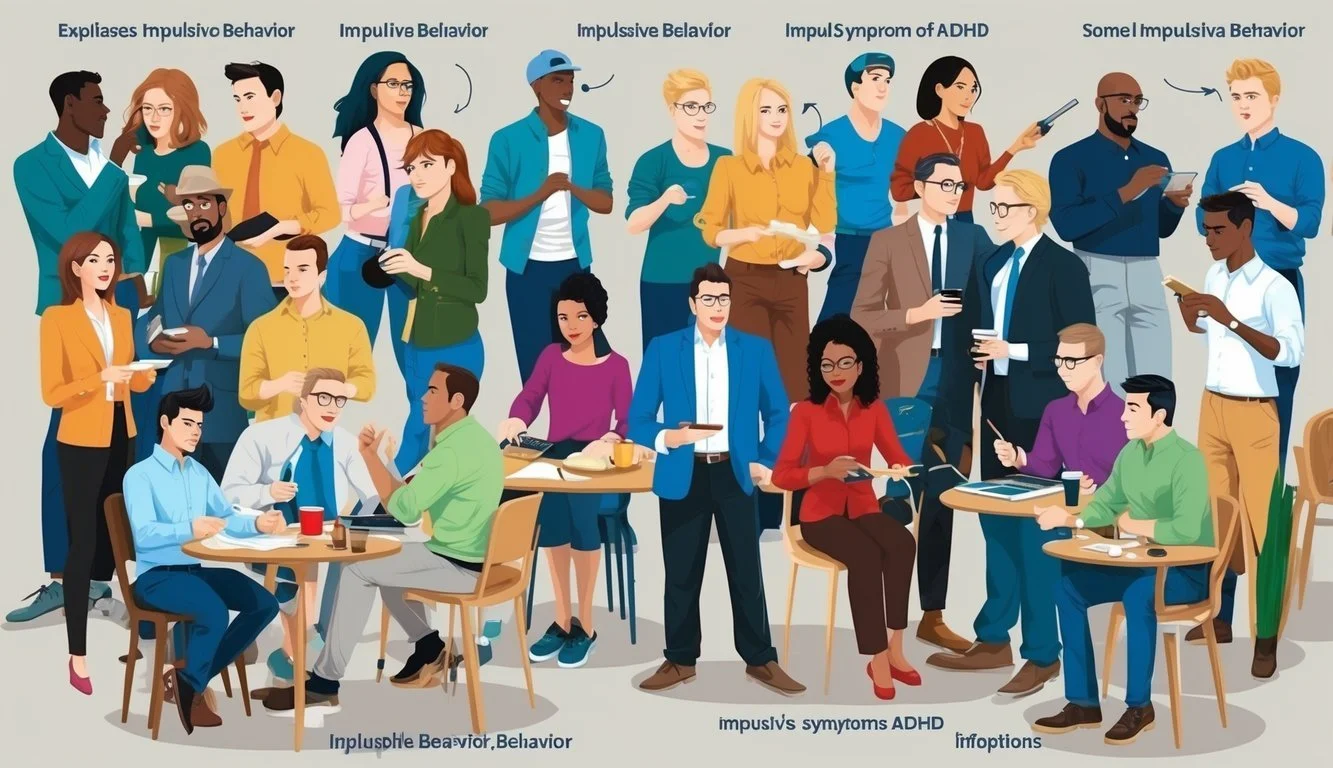Understanding ADHD Impulsivity: Key DSM Criteria for Accurate Diagnosis
Attention-Deficit/Hyperactivity Disorder (ADHD) is a neurodevelopmental condition characterized by persistent patterns of inattention and/or hyperactivity-impulsivity. The Diagnostic and Statistical Manual of Mental Disorders, Fifth Edition (DSM-5), provides specific criteria for diagnosing ADHD, including impulsivity symptoms.
According to the DSM-5, impulsivity in ADHD manifests as hasty actions occurring without forethought and potentially causing harm to the individual. These behaviors may include interrupting others, making important decisions without considering long-term consequences, or having difficulty waiting one's turn. For a diagnosis of ADHD with predominantly hyperactive/impulsive presentation, an individual must exhibit at least six symptoms of hyperactivity-impulsivity for children, or five for adults, persisting for at least six months.
The DSM-5 criteria for impulsivity in ADHD encompass various behaviors that can significantly impact an individual's daily functioning. These may include blurting out answers before questions are completed, difficulty waiting in line, and acting without thinking. Understanding these criteria is crucial for accurate diagnosis and effective treatment planning for individuals struggling with ADHD-related impulsivity.
Understanding ADHD
Attention-Deficit/Hyperactivity Disorder (ADHD) is a neurodevelopmental condition characterized by persistent patterns of inattention, hyperactivity, and impulsivity. These symptoms interfere with daily functioning and development across various life domains.
The Diagnostic and Statistical Manual of Mental Disorders, Fifth Edition (DSM-5) provides specific criteria for diagnosing ADHD. It outlines two main symptom categories: inattention and hyperactivity-impulsivity.
Inattention symptoms include difficulty focusing, forgetfulness, and disorganization. Hyperactivity-impulsivity symptoms involve excessive movement, restlessness, and acting without thinking.
For a diagnosis, children must exhibit at least six symptoms from either category, while adults need five. These symptoms must persist for at least six months and be inappropriate for the individual's developmental level.
ADHD presents in three types:
Predominantly Inattentive
Predominantly Hyperactive-Impulsive
Combined Type
Symptoms must be present in multiple settings (e.g., home, school, work) and cause significant impairment in social, academic, or occupational functioning.
It's important to note that ADHD is a complex disorder. Its impact varies from person to person, and symptoms may change over time. Professional evaluation is crucial for accurate diagnosis and appropriate treatment planning.
Diagnosing ADHD Impulsivity
Diagnosing ADHD impulsivity involves a comprehensive evaluation process. Healthcare providers assess symptoms that have persisted for at least 6 months and occur in multiple settings, such as home and school.
The Diagnostic and Statistical Manual of Mental Disorders (DSM-5) outlines specific criteria for ADHD diagnosis. For impulsivity, clinicians look for behaviors like:
Difficulty waiting one's turn
Blurting out answers before questions are completed
Frequently interrupting or intruding on others
These symptoms must significantly interfere with daily functioning or development.
Professionals may use various tools to gather information, including:
Clinical interviews
Behavioral rating scales
Direct observations
It's crucial to rule out other conditions that might explain the symptoms. ADHD often co-occurs with other disorders, complicating the diagnostic process.
The DSM-5 recognizes three ADHD presentations:
Predominantly inattentive
Predominantly hyperactive/impulsive
Combined presentation
For a predominantly hyperactive/impulsive diagnosis, criteria for hyperactivity-impulsivity must be met, while inattention criteria are not met for the past 6 months.
Accurate diagnosis requires input from multiple sources, including parents, teachers, and the individual. This comprehensive approach helps ensure a thorough evaluation of impulsivity symptoms in ADHD.
DSM-5 Criteria for ADHD
The Diagnostic and Statistical Manual of Mental Disorders, Fifth Edition (DSM-5) outlines specific criteria for diagnosing Attention-Deficit/Hyperactivity Disorder (ADHD). These criteria are divided into two main categories: inattention and hyperactivity-impulsivity.
For a diagnosis of ADHD, symptoms must persist for at least 6 months and be present in two or more settings, such as home, school, or work. The symptoms must interfere with daily functioning or development.
Inattention symptoms include:
Difficulty paying attention to details
Trouble organizing tasks
Easily distracted
Often forgetful in daily activities
Hyperactivity-impulsivity symptoms include:
Fidgeting or squirming
Difficulty remaining seated
Talking excessively
Interrupting others
The DSM-5 recognizes three presentations of ADHD:
Predominantly Inattentive
Predominantly Hyperactive-Impulsive
Combined Presentation
For children up to age 16, at least six symptoms from either category must be present. For individuals 17 and older, only five symptoms are required. Symptoms must be inappropriate for the person's developmental level and not better explained by another mental disorder.
Impulsive Behaviors in ADHD
Impulsivity is a core symptom of Attention-Deficit/Hyperactivity Disorder (ADHD). It manifests through various behaviors that can impact daily functioning and relationships. These behaviors vary across different age groups and can change over time.
Symptoms of Impulsivity
Impulsive behaviors in ADHD often appear as hasty actions without forethought. Common symptoms include:
Interrupting others during conversations
Difficulty waiting for one's turn
Making rash decisions without considering consequences
Blurting out answers before questions are completed
Acting without thinking in potentially dangerous situations
These behaviors can lead to social difficulties and increased risk-taking. Impulsivity may also manifest as impatience, especially when faced with delayed gratification.
Impulsivity Across Different Age Groups
Impulsive behaviors can present differently depending on age:
Children:
Frequently interrupt others
Have trouble waiting in line
Act without permission
Engage in physically dangerous activities
Adolescents:
Make impulsive financial decisions
Exhibit risky sexual behavior
Struggle with substance experimentation
Display aggressive outbursts
Adults:
Make impulsive career changes
Struggle with relationship commitments
Experience difficulty managing finances
Engage in risky driving behaviors
As individuals age, impulsivity may become less overt but can still significantly impact various aspects of life. Recognizing these age-specific manifestations is crucial for accurate diagnosis and effective treatment.
ADHD Impulsivity Management
Managing ADHD impulsivity involves a multi-faceted approach. Effective strategies include behavioral interventions, medication, and lifestyle modifications. These methods can help individuals with ADHD gain better control over impulsive behaviors and improve their overall functioning.
Behavioral Interventions
Cognitive Behavioral Therapy (CBT) is a cornerstone of ADHD impulsivity management. This approach helps individuals identify and modify thought patterns that lead to impulsive actions. CBT techniques often include self-monitoring, problem-solving, and impulse control strategies.
Mindfulness meditation has shown promise in reducing impulsivity. Regular practice can enhance attention and emotional regulation. Mindfulness exercises may involve focused breathing, body scans, or guided imagery.
Social skills training can be beneficial, especially for children with ADHD. This intervention teaches appropriate social behaviors and helps reduce impulsive interactions. Role-playing and modeling are common techniques used in this training.
Pharmacological Treatments
Stimulant medications are the most commonly prescribed treatments for ADHD impulsivity. These drugs, such as methylphenidate and amphetamines, work by increasing dopamine levels in the brain. They can significantly improve impulse control and attention.
Non-stimulant medications are an alternative for those who don't respond well to stimulants. Options include atomoxetine, guanfacine, and bupropion. These medications affect different neurotransmitters and can help manage impulsivity symptoms.
Combination therapy, using both stimulant and non-stimulant medications, may be prescribed in some cases. This approach can provide more comprehensive symptom relief for individuals with complex ADHD presentations.
Lifestyle and Dietary Changes
Regular exercise has been shown to reduce ADHD symptoms, including impulsivity. Physical activity can improve focus, boost mood, and decrease hyperactivity. Aerobic exercises and team sports are particularly beneficial.
Adequate sleep is crucial for managing ADHD impulsivity. Establishing a consistent sleep schedule and practicing good sleep hygiene can help regulate mood and improve impulse control.
Dietary modifications may play a role in managing ADHD symptoms. Some studies suggest that reducing sugar and artificial additives intake can help. Increasing omega-3 fatty acids through diet or supplements may also be beneficial.
Stress reduction techniques, such as yoga or progressive muscle relaxation, can help manage impulsivity. These practices promote relaxation and improve emotional regulation.
Time management and organizational skills training can indirectly reduce impulsive behaviors. By improving planning and prioritization, individuals with ADHD can better manage their daily tasks and reduce stress-induced impulsivity.
Impacts of ADHD Impulsivity
ADHD impulsivity can significantly affect various aspects of a person's life. It often leads to challenges in social interactions, educational pursuits, and occupational settings.
Social Challenges
Impulsivity in ADHD can strain relationships and social interactions. Individuals may interrupt conversations frequently, blurt out inappropriate comments, or act without considering consequences. This behavior can lead to misunderstandings and conflicts with friends, family, and colleagues.
Some people with ADHD impulsivity struggle to maintain long-term friendships due to their unpredictable actions. They may also have difficulty reading social cues or respecting personal boundaries.
In romantic relationships, impulsive decisions or statements can cause trust issues and emotional turmoil. Partners may find it challenging to cope with sudden mood swings or impulsive financial choices.
Educational Difficulties
Students with ADHD impulsivity often face unique challenges in academic settings. They may have trouble waiting their turn to speak in class or blurt out answers before questions are finished.
Impulsive behaviors can disrupt study sessions and homework completion. Students might rush through assignments without carefully reading instructions, leading to careless mistakes.
Test-taking can be particularly challenging. Impulsive students may answer questions hastily without fully considering all options. This can result in lower grades despite having the necessary knowledge.
• Difficulty following multi-step instructions • Tendency to start projects without proper planning • Struggles with time management and prioritization
Occupational Impacts
In the workplace, ADHD impulsivity can affect job performance and career progression. Employees may struggle with meeting deadlines due to poor time management or difficulty prioritizing tasks.
Impulsive decision-making can lead to errors in judgment, potentially causing costly mistakes or safety hazards. This is particularly concerning in high-stakes professions like healthcare or finance.
Interpersonal relationships at work may suffer due to impulsive communication. Employees might speak out of turn in meetings or respond to emails without careful consideration.
Career advancement can be hindered by impulsive job-hopping or difficulty maintaining long-term professional goals. However, in some creative fields, impulsivity can lead to innovative ideas and quick problem-solving.
ADHD in Different Populations
Attention-deficit/hyperactivity disorder (ADHD) manifests differently across age groups and genders. The presentation and impact of ADHD symptoms can vary significantly, influencing diagnosis and treatment approaches.
ADHD in Children
ADHD often first emerges in childhood. Children with ADHD may struggle with staying focused, following instructions, and controlling impulsive behaviors. These challenges can affect their academic performance and social relationships.
In school settings, children with ADHD might have difficulty sitting still, completing assignments, or waiting their turn. They may appear easily distracted or forgetful about daily activities.
Diagnosis typically involves input from parents, teachers, and healthcare professionals. Treatment often combines behavioral therapy and, in some cases, medication. Early intervention can help children develop coping strategies and improve their overall functioning.
ADHD in Adults
ADHD persists into adulthood for many individuals. Adult ADHD symptoms may be less obvious than in children but can still significantly impact daily life. Adults with ADHD may struggle with time management, organization, and maintaining focus on tasks.
Impulsivity in adults can manifest as risky behaviors, difficulty in relationships, or problems at work. Many adults with ADHD report feelings of restlessness or difficulty relaxing.
Diagnosis in adulthood can be challenging, as symptoms may overlap with other conditions. Treatment often involves a combination of medication, cognitive behavioral therapy, and lifestyle adjustments.
Gender Differences in ADHD
ADHD presentation can vary between males and females. Historically, ADHD has been diagnosed more frequently in males, but research suggests this may be due to differences in symptom expression.
Boys tend to exhibit more hyperactive-impulsive symptoms, which are often more noticeable. Girls may show more inattentive symptoms, which can be less disruptive and harder to identify.
In adulthood, women with ADHD may experience unique challenges, such as difficulties with emotional regulation and self-esteem. Hormonal changes can also influence symptom severity in women.
Recognizing these gender differences is crucial for accurate diagnosis and effective treatment across the lifespan.
Comorbidity and ADHD Impulsivity
ADHD frequently co-occurs with other mental health conditions, complicating diagnosis and treatment. The presence of comorbid disorders can significantly impact the expression and management of ADHD symptoms, particularly impulsivity.
ADHD and Co-Existing Disorders
ADHD rarely occurs in isolation. Studies show that up to 93% of children with ADHD have at least one comorbid disorder. Common co-occurring conditions include oppositional defiant disorder, conduct disorder, anxiety disorders, and learning disabilities.
These comorbidities can exacerbate ADHD symptoms and create unique challenges in treatment. For example, a child with both ADHD and anxiety may struggle more with impulsivity in social situations due to heightened stress levels.
Healthcare providers must carefully assess for comorbid conditions to develop comprehensive treatment plans. Addressing co-existing disorders alongside ADHD can lead to better overall outcomes for patients.
Substance Use Disorders
Individuals with ADHD have a higher risk of developing substance use disorders (SUDs). The impulsivity associated with ADHD can contribute to risky behaviors and difficulties in resisting substance use.
Studies indicate that:
15-25% of adults with SUDs also have ADHD
ADHD increases the risk of early-onset substance use
Untreated ADHD may lead to self-medication with drugs or alcohol
Treatment for comorbid ADHD and SUD often involves a combination of medication, behavioral therapy, and substance abuse counseling. Addressing both conditions simultaneously is crucial for effective recovery and symptom management.
Mood Disorders
ADHD frequently co-occurs with mood disorders such as depression and bipolar disorder. The relationship between ADHD and mood disorders is complex, with overlapping symptoms that can complicate diagnosis.
Key points:
Up to 30% of adults with ADHD also have major depressive disorder
Bipolar disorder occurs in 5-20% of individuals with ADHD
Mood disorders can intensify ADHD symptoms, particularly impulsivity
Treatment approaches for comorbid ADHD and mood disorders typically involve a combination of medications and psychotherapy. Careful medication management is essential, as some ADHD medications may exacerbate mood symptoms.
Clinicians must closely monitor patients with co-occurring ADHD and mood disorders to ensure optimal treatment outcomes and minimize potential risks associated with impulsivity.
Recent Research on ADHD Impulsivity
Recent studies have focused on refining the diagnostic criteria for ADHD impulsivity in adults. The DSM-5 introduced important changes, including four new impulsivity symptoms and a reduction in the number of symptoms required for diagnosis.
These modifications aim to improve the accuracy of ADHD diagnoses in adult populations. Researchers have examined the reliability and validity of these proposed changes in clinical samples.
One study involving 133 adults found that the new DSM-5 criteria demonstrated good performance in identifying ADHD cases. The additional impulsivity symptoms helped capture adult manifestations of the disorder more effectively.
Neurobiological research has explored the brain structures associated with impulsivity in ADHD. Studies have identified abnormalities in both gray and white matter that may contribute to impulsive behaviors.
Comparative studies have also examined impulsivity in ADHD and other conditions like Borderline Personality Disorder. This research aims to better understand the shared and distinct neural correlates of impulsivity across different disorders.
Pharmacological interventions for ADHD impulsivity continue to be a focus of research. Scientists are evaluating the efficacy and acceptability of various medications in managing impulsive symptoms across different age groups.
Support and Resources for ADHD
Individuals with ADHD can access various support systems and resources to manage their condition effectively. Professional help from psychiatrists, psychologists, and therapists specializing in ADHD is crucial for accurate diagnosis and treatment.
Many organizations offer educational materials, support groups, and workshops for people with ADHD and their families. These resources provide valuable information on coping strategies, time management techniques, and lifestyle adjustments.
Online communities and forums allow individuals to connect with others facing similar challenges, share experiences, and exchange advice. These platforms can be particularly beneficial for those seeking peer support and understanding.
Schools and workplaces often provide accommodations for individuals with ADHD. These may include extended time for tasks, quiet work areas, or assistive technologies to enhance focus and productivity.
Medication management, when prescribed by a healthcare provider, can be an essential component of ADHD treatment. Regular follow-ups ensure the effectiveness of prescribed medications and allow for necessary adjustments.
Cognitive-behavioral therapy (CBT) and other evidence-based therapies can help individuals develop coping mechanisms and improve their organizational skills. These interventions are often tailored to address specific ADHD-related challenges.
Local ADHD support groups offer a safe space for individuals to discuss their experiences, learn from others, and receive emotional support. Many of these groups are facilitated by trained professionals or experienced peers.





